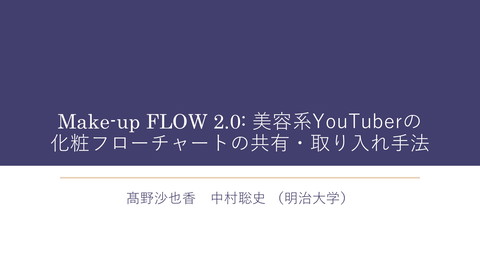A Method for Supporting Verbalization to Facilitate Observation in Illustration Copy-Drawing
111 Views
November 03, 21
スライド概要
ICEC2021
明治大学 総合数理学部 先端メディアサイエンス学科 中村聡史研究室
関連スライド
各ページのテキスト
A Method for Supporting Verbalization to Facilitate Observation in Illustration Copy-Drawing Ippei Sugano Satoshi Nakamura Meiji Univercity Nakamura Laboratory
Outline Target : Illustration beginners Purpose : Encouraging beginners to observe when creating illustrations Method : Verbalizing the characteristics of the object to be observed during observation Contribution • We have clarified the effectiveness of the proposed method. • We proposed a system for support.
Introduction Beginners who challenge digital illustration by themselves. it is difficult to create an illustration by yourself. Especially for beginners, the following problems occur. • They can't draw as they want • Out of balance and color
Pictures drawn by beginners
Observation when drawing a picture Observation is important in illustration production By observing enough, the balance, color, light, and details of the person's painting can be consistent.
The picture of Apples drawn by a beginner Sample Bad observation
The picture of Apples drawn by a beginner Sample Bad observation The part where the apple on the upper left is visible is smaller than the actual one.
The picture of Apples drawn by a beginner ■ ■ ■ ■ Sample Bad observation The red color of the apple in this picture is drawn in a darker red color. The area around the calyx is orange.
The picture of Apples drawn by a beginner Sample Bad observation Good observation The picture on the right shows the red tint of the base and the size more accurately.
The picture of women drawn by a beginner Sample Bad observation
The picture of women drawn by a beginner Sample Bad observation Comparing the size of the face and shoulders, you can see that the picture drawn by the beginner has a small face.
The picture of women drawn by a beginner Sample Bad observation There is no depiction in the picture that is black under the mouth or in the shadow.
Problems for beginners • Many beginners are supposed to observe well → In reality, they do not fully observe
Reseach question Beginners can't draw as they want because they don't observe enough. We thought we need a way to encourage observation and deepen our thoughts.
Related reseaches Shadow draw (Yong Jae Lee, Larry Zitnick, and Michael Cohen, 2011.)
Related reseachs DrawMyPhoto: Assisting Novices in Drawing from Photographs (Blake Williford, Abhay Doke, Michel Pahud, Ken Hinckley, Tracy Hammond 2018)
Purpose Encouraging beginners who create illustrations by themselves to observe In this study, we will verify the copy-drawing, which is a general practice method and observation is especially important.
Method → Prompt observation by outputting in words By outputting in words, • Consider carefully when drawing • Be more conscious and observe ・color ・shadow ・shape ・balance
Experiment purpose We have verified the following. By verbalizing what you noticed about the object to be observed during observation and copying, • Whether beginners can notice • Whether beginners can reflect in the picture
State during the experiment No verbalization Display a sample LCD tablet
State during the experiment Verbalization Display a sample Paper to write what you noticed LCD tablet
Comparison between experimenters Verbalization No verbalization
Comparison between experimenters Verbalization No verbalization
Comparison between experimenters Verbalization No verbalization
Comparison between experimenters Verbalization No verbalization
Results of repeated measurements • More drawing in small parts Sample No verbalization Verbalization
Results of repeated measurements • More drawing in small parts Sample No verbalization Verbalization
Results of repeated measurements • More drawing in small parts Sample No verbalization Verbalization
Results of repeated measurements • More drawing in small parts Sample No verbalization Verbalization
Result of Subjective evaluation *(p<0.05) How satisfied are you with Did you draw well as a How similar it is to the the picture? copy? sample? 7 7 7 6 6 5 5 5 4 4 4 3 3 3 2 2 2 1 1 1 * 6 No verbalization Verbalization No verbalization Verbalization No verbalization Verbalization
Consideration • There were many descriptions of the parts that were noticed under the condition of verbalization. • More drawing in small parts → We were able to encourage observation The result of subjective evaluation was higher with verbalization → They can draw as they want
Consideration ■No verbalization ■ Verbalization • The objective evaluation varied from person to person, and some people had verbalization and had low scores. • All objective evaluation scores were 50% or less. → The observation is not fully reflected in the picture
System Observation instructions Image to be observed Text box
Conclusion • Our method proved that the painter was more satisfied with his painting. • Our method has increased the fine drawing of pictures. • The observation is not fully reflected in the picture • It is necessary to encourage observation of relative parts such as the position and size of parts.





